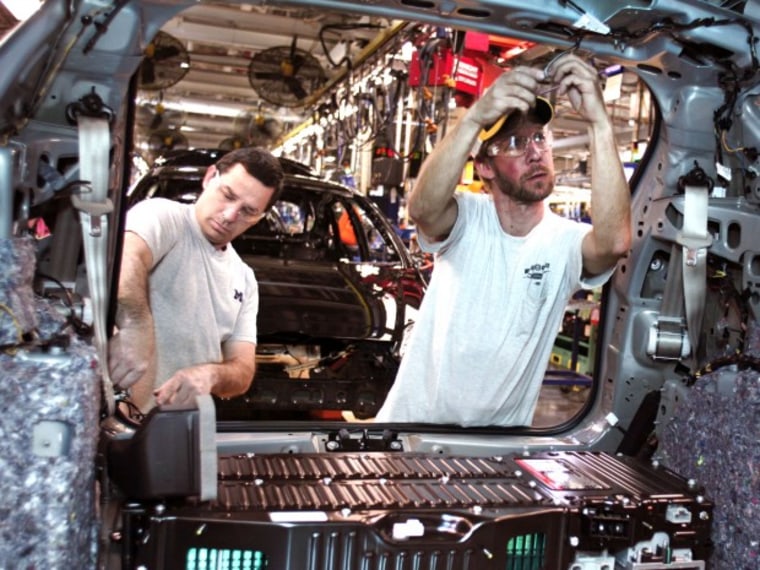Vanessa Billock graduated with a degree in literature. This week she’ll start assembling the first Ford Fusions to be built in the United States.
“When I was in college and I was like ‘hey, I’m studying literature,’ you always got the question of ‘are you gonna be a teacher or are you gonna be unemployed?’” the 24 year old said. After school, her mother said there were openings where she worked—Ford’s Flatrock Assembly Plant.
So--like her parents, grandparents, and one great-grandparent--Billock took a job with Ford. She is one of the 1,400 brought on to begin assembling the Ford Fusion, a car that was made exclusively in Mexico until now. With Fusion sales up 13% from last year and Ford’s Mexico plant producing at capacity, Ford added its popular mid-size car to the Detroit suburb plant’s production lineup, increasing production of the car by 30%.
“Those jobs could have gone to other places,” Flatrock Assembly Plant’s manager Tim Young said. “Ford has got a real strategy of investing in America and that’s what’s happening here. We’ve invested $550 million dollars [in the Flatrock plant].”
The new jobs are part of a promise Ford made. In 2011, the company vowed in a deal with the United Automotive Workers Unions to add or retain 12,000 jobs to the U.S. by 2015 and in-source manufacturing from Mexico, Japan, and China.
It's a homecoming, of sorts, for a company and industry that is seeing a slow, hard-earned revival. A decade ago, one in ten American jobs was tied to the American automotive industry, centered in Detroit.
The recession hit and auto sales fell by a third. The so-called ‘big three’—Chrysler, General Motors, and Ford—teetered on the edge of bankruptcy, threatening millions of jobs. Chrysler and GM were bailed out, while Ford went through a massive restructuring.
Detroit and Ford were hard hit. In just under 15 years, Ford’s operations in southeast Michigan were cut by more than half, dropping from their peak of 48,702 hourly employees in 1996 to its lowest point, in 2011, with 19,597 employees.
“I lost a lot of good friends,” Young said. “It was very, very tough. You’re starting to question is there gonna be an auto business in the United States.”
But the Big Three are fighting their way back.
August’s car sales are on track to hit their highest monthly sales record since 2006. Ford posted 5.67 billion in profits last year; GM and Chrysler both reported billions in profits, too.
Experts credit the growth to two key factors: American cars, once poorly reviewed when compared to their international competitors, are increasingly competitive, well-made, and stylish. Though imported cars are still expected to rank at the top this year, Ford’s Fusion is closing the sales gap with the Toyota Camry for the best-selling car in the U.S.
On the other side of the recession, restructurings, and bailouts, the big three have also become leaner, more efficient manufacturers. Fusion production will add a second shift to Ford’s Flatrock plant, optimizing the plant and increasing productivity.
Other American auto assembly plants are doing the same thing: by the end of this year, half of all Ford, GM, and Chrysler cars built in the U.S. will come from plants with three shifts, industry consulting firm IHS Automotive told CNBC, meaning plants are productive 22 hours a day. Four years ago, less than 5% of all cars came from these efficient plants.
For Young, it’s a “complete turnaround”—one that’s particularly visible in its new employees.
“It’s different than about 10 years ago, where there was so much hiring and lots of options about jobs and they got to pick and choose and it was corralling the people,” Young remembered. “Now, we’re going to them very differently and we spend a week of orientation with every new employee. They go through a simulated factory training, and at the end of the week when I meet with them and I ask them how was their week, I get a standing ovation.”
People are grateful to find good jobs, he said.
“A job in the automotive business is really a very, very good job, and people are coming in extremely enthusiastic about being able to get these jobs,” he said.
Michigan’s unemployment rate is 8.4%, higher than the national average of 7.4%.
For Billock, it’s a mixture of pride and reality.
“It’s a lot of growing up and realizing the economy does factor into my life now…It started out as that ‘gotta get my big girl job now,’ but it’s becoming one of those passions,” she said. “Growing up, it was always ‘you better have a Ford car’… The more I thought about it, I was like, ‘my mom built that car! My dad built that car! That’s real. And now I’m building it! And that’s awesome.”
Morning Joe’s Brian Shactman and Eric Leffler reported from Detroit.
